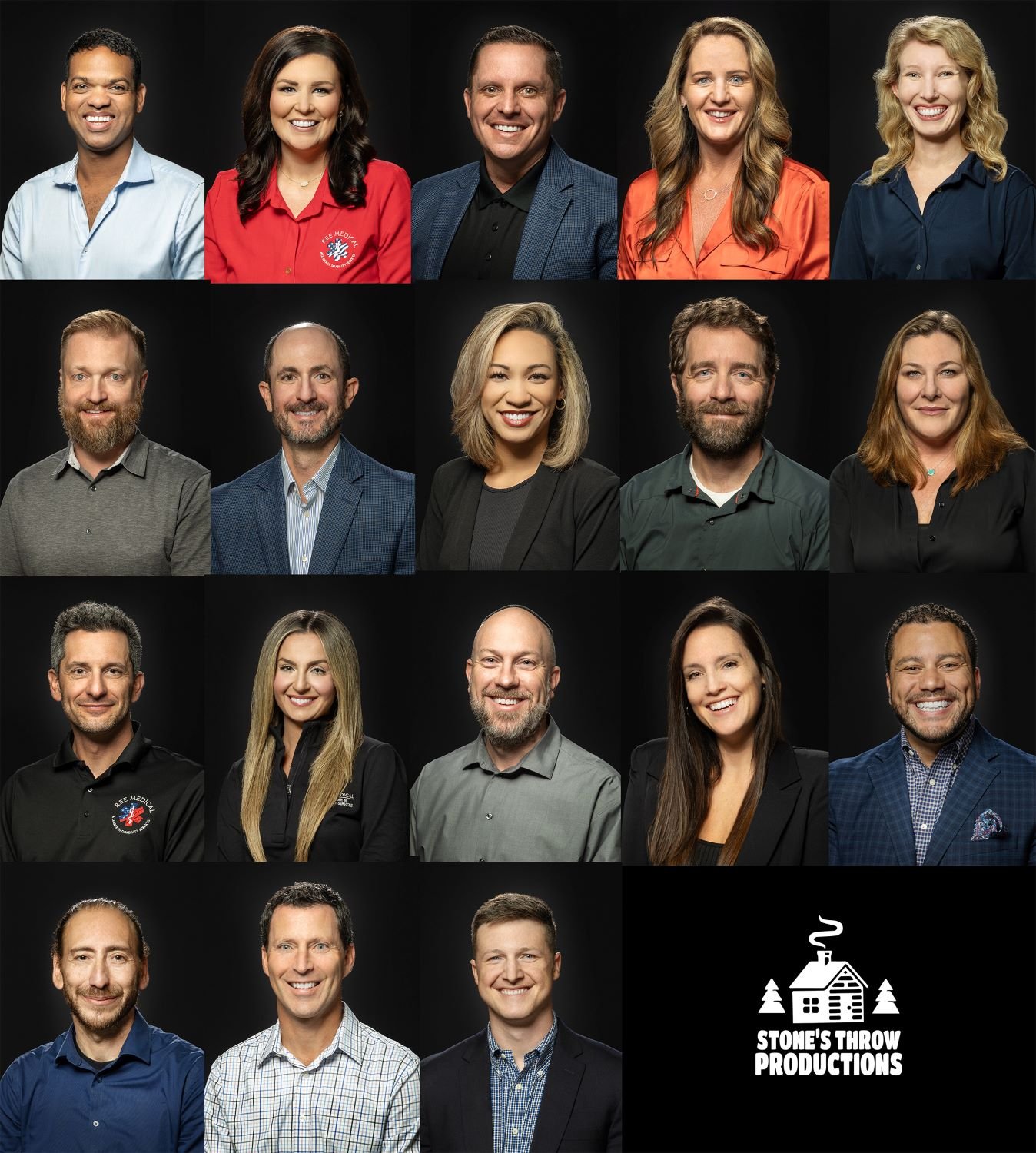Corporate Headshots: How to Have a Smooth Picture Day
Getting headshots for your entire office can be logistically challenging. There are a lot of people involved and ensuring that everything goes smoothly without interrupting people’s busy schedules can be difficult. In this blog, I will give you tips on how to get your office and employees ready for their headshots so the day goes smoothly. I’ll also give some tips at the end for photographers so they can do their part to keep things organized.
Create a Schedule for the Day
The first thing you should do is create a schedule for the day/days it will take to get the headshots done. Have a chat with your photographer to see how long it usually takes them to set up and do a single headshot. Something to consider when deciding which photographer to hire is the tradeoff between time and quality. You might have a photographer who can get each person done in 30 seconds or less, which can be great for large companies and short timeframes. If there is an employee who is nervous in front of the camera or who looks a bit awkward in their picture taken of them, that may get overlooked and you’ll just have to use what you get. If you can afford at least 2-3 minutes per person photographed, the photographer will have much more time to work with each person and get the best possible picture of everyone, including fixing hair and outfits and working with them on their expression. Neither way is wrong, but like I said, there is a tradeoff.
Once you have an idea of how long it will take to photograph everyone, you should create a schedule for the day with timeslots that people can sign up for. Your photographer may be able to do this for you, but either way, this schedule should be shared with employees then given back to both you and the photographer. I recommend leaving a bit of room for people to reschedule if they miss their timeslot for an unforeseen reason.
Communication is Key
No matter how organized you are, there will be people who don’t sign up for a timeslot, forget about their timeslot, aren’t ready to go during their time, take longer than anticipated to get their picture done, etc. This is why clear communication is very important. Simply sending out the schedule in a company-wide email is not enough. Make sure people know that they must show up for their timeslot ready to go. This means being dressed for it, at the photographer’s station, ready to sit in front of the camera. Even though there will be opportunities to reschedule, don’t say that since, in my experience, this will make people not take their timeslot as seriously. It really is a numbers game. If 5% of people miss their timeslot, that’s ok. If 25-30% of people miss their timeslot, are late, aren’t ready to go, etc, the schedule will continue to be pushed back, impacting everyone for the rest of the day.
Being on top of this is more important if you are going for a quick turnaround (under a minute per person). If your schedule allows 2 minutes or more per person, you’ll be in better shape since some people will be done very quickly and that extra time in their slot can be used to catch up. All-in-all, lack of clear communication is the quickest way to create stress and chaos during picture day. Try framing the headshots as a perk that the employees get for free since this is normally are something you pay for.
What to Expect Day Of
On picture day, here’s what to expect and how to help things go smoothly.
Your photographer will need some time to set up. Depending on their setup, this can take anywhere from 15 minutes to an hour. Make sure to ask them how long they will need to set up and to let them know about what the trip from their car to the setup location will be like so they can plan accordingly. It is helpful to have a separate space for the photos to reduce distractions, so if you have a conference room or something similar, that will work perfect (unless you are using your office as the background). Make sure everyone having their picture taken knows exactly where it is happening so they aren’t wandering around during their timeslot.
Depending on the number of people and your budget, the photographer may bring an assistant with them to help check people in and ensure things are moving along. In my experience, it is also incredibly helpful if you can assign someone from the office to help out with tracking people down who don’t show up for their timeslot and reminding them that they have a scheduled timeslot coming up. Your photographer will not know the layout of the office or any of the people working in it, so having someone familiar with the space and employees can be invaluable.
As for the actual procedure of the headshots, it is very simple. You show up at your scheduled time ready to go, give your name to the photographer or assistant to they can keep track of progress and who is being photographed, get your picture taken and done! If there is enough time, the photographer will work with each person to get the most flattering picture possible. If not, it may be a simple “smile” and done. If this is the case, I’d recommend asking your photographer if they have any tips on posing for a headshot so you can send them out to people along with the timeslot signup. They may already have a guide prepared for this exact scenario (wink wink).
For more info to help get you prepared, check out my guide on What to Wear for Your Professional Headshots
Tips for Photographers
That all may have sounded like a lot of work to plan and coordinate, and some of that work will also fall on you. None of this planning will matter if you are not organized and ready to go as well.
It is important that you have an iea of how long it takes you to do a headshot. There is not a target time you should be striving for, just be honest with yourself. Think about what your headshot standard is. For me personally, I don’t want even a single headshot from the group to look bad, so I make sure to say I’ll need at least 3-5 minutes per headshot. Some people will take a fantastic photo in 30 seconds, but giving myself that time ensures that I will be able to work with people who are struggling without getting behind and not settle for an akward smile or unflattering angle. That being said, be aware that the longer you take to get a headshot, the harder it will be for you to book higher volume jobs.
You should also have a setup that works consistently. By this I don’t mean equipment that’s reliable (although you really should have that), I mean a lighting setup that you won’t have to drastically change person to person. You might really like a moody lighting setup you did for someone in the past that perfectly accentuates their features, but that will not work for 200 people in a row. I recommend a key light with a softbox somewhere between a Rembrandt and butterfly position, a fill light or reflector filling in shadows, and a hair light poking out above your backdrop. This is just what works consistently for me, do your thing! Just keep in mind the last thing you want to be doing when pressed for time is moving lights around between each person.
The most important thing to keep the day moving smoothly is to have a system for knowing who you’re photographing and where you are in the schedule. The system I use is a slate with the person’s name. When a person shows up ask for their name, write it down or type it out (on a notebook, white board, or tablet) then take a picture of it with your camera. If you have an assistant with you, this should be their job. This helps a ton after the fact because when you see a picture of a name, you’ll know the next headshots on your card are for that person. I think delivering your photos grouped by person adds a lot to your client experience. That way there is not a sea of photos they have to sort through after the fact. It significantly reduces the amount of work your client will have to do when they receive the photos.
Last thing I’ll quickly mention is to have a good system for packing, unpacking, and transporting your gear to and from your car. You’ll look more professional, be in and out quicker, and won’t have to deal with the embarrassment of leaving something behind because you aren’t organized with packing your gear. Good luck!
If you want more advice on headshots, check out my Posing Tips to Make Your Subject Look More Confident
Headshot Photography in Denver Colorado
If you read this and want a photographer who has experience with these types of shoots and the logistics involved, don’t hesitate to reach out! I can’t help you through the entire process and you can be sure I will be able to keep the day moving as smoothly as possible. Can’t wait to hear from you!




